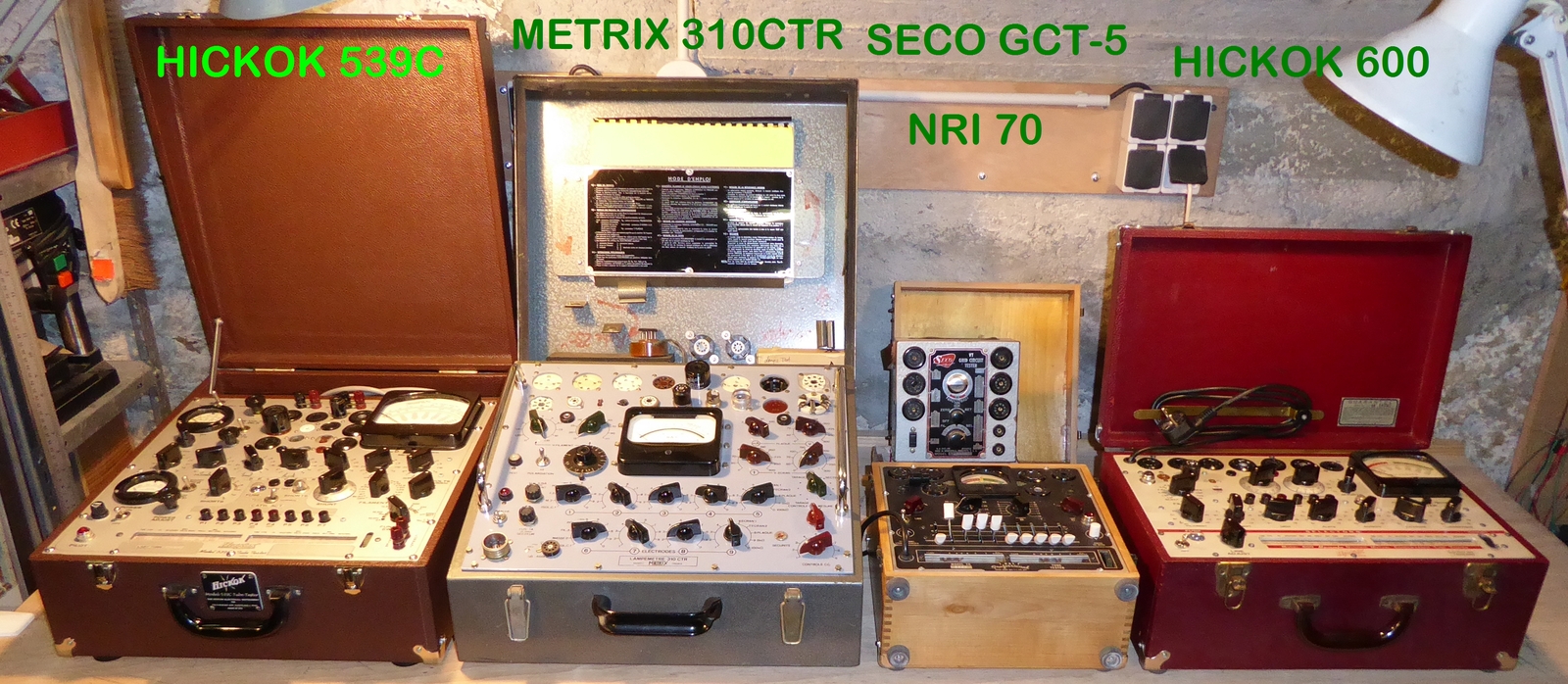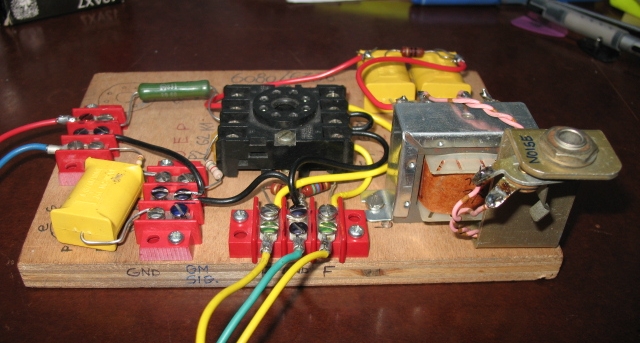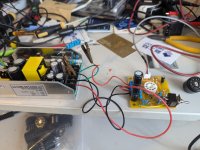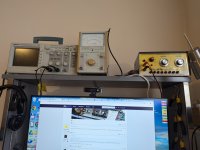Hello!
I hope you guys do not mind me picking your brain once more. I got a bunch of NOS/used tubes, mostly television ones. I do not have a tube tester (planning to make a simple one, but that's way ahead), and I was wondering if I can just use a simple circuit to characterise the tubes and finding matched ones. I have been testing double triodes in a common cathode circuit, and the measurement is pretty consistent with datasheet curves and simulations when the tubes are good.
Q1: Is this a good approach for tube testing and matching in the absence of a proper tube tester?
Q2: For testing a power triode-pentode (E/PCL8x), would you test then with an output transformer, like a real SE circuit? or just best keep it simple, using a resistor as a load?
Regards,
Jose
I hope you guys do not mind me picking your brain once more. I got a bunch of NOS/used tubes, mostly television ones. I do not have a tube tester (planning to make a simple one, but that's way ahead), and I was wondering if I can just use a simple circuit to characterise the tubes and finding matched ones. I have been testing double triodes in a common cathode circuit, and the measurement is pretty consistent with datasheet curves and simulations when the tubes are good.
Q1: Is this a good approach for tube testing and matching in the absence of a proper tube tester?
Q2: For testing a power triode-pentode (E/PCL8x), would you test then with an output transformer, like a real SE circuit? or just best keep it simple, using a resistor as a load?
Regards,
Jose
Q1: Is this a good approach for tube testing and matching in the absence of a proper tube tester?
Yes indeed.
Q2: For testing a power triode-pentode (E/PCL8x), would you test then with an output transformer, like a real SE circuit? or just best keep it simple, using a resistor as a load?
It would be better if you can use a little output transformer of the correct impedance.
I have several tube testers to attest that :

Testing a tube with a dedicated temporary circuit that meets the datasheet conditions is of course one of the best solutions, so you are right @jcalvarez ! 🙂

But of course, I assume that you have the adequate supplies and meters to achieve the correct measurement conditions... 😉
T
I have a regulated power supply that can provide 325V @ 100mA. I have a scrap chassis that I use for 9 pin tubes that I test for the data sheet operating points. For power tubes I have a second chassis with a 450V supply.

Without a tube tester all you can do is test the tube filament with an ohm meter. TV tubes are worth about nothing.
You are joking, right? Because if not, that's scary...Without a tube tester all you can do is test the tube filament with an ohm meter. TV tubes are worth about nothing.
The OP is asking if he can use a test setup jig to test tubes at the operating points in the tube manual. This works well for me.
I have a TV7 so I'm not totally ridiculous. I simply prefer to test the tube under real world condition; ridiculous as that sounds...
Palustris, your post has nothing to do with the original post. Poster did not ask to test TV tubes under real operating condition and why would they.
Following your logic we should buy amplifiers instead of building them.No joke. Building a tester for a tube is ridiculous. Buy a tube tester.
I'm not interested in buying a valve tester, I prefer to build one, when I have the time. What may be ridiculous for you is fun for me.
Some are worth nothing, some are highly sought after, especially NOS and matched, like 12BH7s, E/PCC88s, PL519s. The list goes on and on.TV tubes are worth about nothing.
That's exactly what I meant, testing the devices in a real circuit, like for example double triodes using a single stage common cathode circuit?Palustris, your post has nothing to do with the original post. Poster did not ask to test TV tubes under real operating condition and why would they.
Can you just go pollute another thread with your continuous handwaving?
This is what I'm using right now to test double triodes. The board is from China, classic two channel common cathode single triode stage
...And the meters and generator.
...And the meters and generator.
Attachments
Last edited:
Building a tube tester for one power tube at real world conditions is valid, but building multiple jigs to test worthless TV tubes is not practicable.
What do you mean by 'characterise'? The datasheet gives you the characteristics, unless you're trying to figure out some mystery tubes with no labels.I was wondering if I can just use a simple circuit to characterise the tubes and finding matched ones.
For matching you can just set up a simple circuit and compare the bias voltages between samples, or whatever parameter you want to match.
The data sheets gives some operating conditions but far from all possible.The datasheet gives you the characteristics
For example pentode/beam tetrode data sheets only provide anode curves for a very few screen voltages.
Sometimes only one screen voltage is provide on the data sheet.
Parameters can be traded off against each other and the data sheet normally only gives you a small subset of what is possible.
Tubes were in the past often designed to solve a particular application.
However there is often a opportunity to use a tube in novel applications if the tube is operated with values that are not provided for on the data sheet.
I use a uTracer3+ to acquire Ia curves verses Va - Vg2 - Vg1.
Often tubes designed for one application can be repurposed for other applications. I find the quest for using tubes in novel ways enjoyable.
By the way the uTracer3+ is a kit so you built it your self.
Actually a reread of the first post will confirm this is pretty much what is being asked.Poster did not ask to test TV tubes under real operating condition and why would they
Some of the TV tubes designed for color TV production from the 1960s were advanced designs and provide interesting and advanced performance opportunities in audio use.
Most "tube testers" were very limited in what it tells you about characteristics of tubes in "off" data sheet use.
They were mostly made to say good/bad.
A select few tube testers will actually accurately confirm data sheet values and even fewer still will allow you to measure some novel data values not on the data sheet. The AVO mark iii is one that come to mind that can measure accurately novel values not on the data sheet.
Curve tracers like the Tecktronics and utracer allow you to gather full details of a tube's characteristics.
This data can let you repurpose tubes in ways the original tube designer never intended. This can be fun if you do not mind a few of your ideas to be failures on-long the way.
Finally making one off test jigs for select tubes is often the best way to fine tune operation parameters for a intended use.
There is no one right way to test tubes but many ways all of witch add some value under some conditions.
So go and have a fun experimenting.
TV tubes made for vertical output service especially later tube designs for large color TV can make very linear output devices.
This is because to make a geometrically accurate image the vertical output amplifier had to have very distortion.
They also tend to be rugged as they were designed to run "flat out" in TV service for years.
Horizontal output tubes can often sink very high current and so produce large amount of output power into a low impedance. Unfortunately some are a bit less linear that traditional audio tubes and can be a bit changeling to design with. Good results are very possible with some care. Again these are tough tubes that will take some abuse.
Some of the high frequency pentodes used in color TV can be used in triode mode to produce impressively linear high gain low level amplification stages.
Some care needs to be taken like always using a grid stopper to prevent high frequency oscillations due to the high transconductance of some of these tubes.
I recently used a russia 6Z51p pentode in triode mode to realize 51dB of gain in a single stage with less than 0.5% distortion at 25V RMS output voltage with zero feed back. Bandwidth went out into the 100s of Khz.
Oh yes color TV damper tubes can make perfect full wave power rectifier tubes when used in pairs. I have not bought a "normal" rectifier tube in years since I started using TV damper tubes.
There are also a number of Russian damper tubes like the 6C10P that two of will nicely replace a 5AR4 (filament voltage adjusted of course to 6.3V) in lots of amplifier designs. They and similar can be found for a dollar or two each.
This is because to make a geometrically accurate image the vertical output amplifier had to have very distortion.
They also tend to be rugged as they were designed to run "flat out" in TV service for years.
Horizontal output tubes can often sink very high current and so produce large amount of output power into a low impedance. Unfortunately some are a bit less linear that traditional audio tubes and can be a bit changeling to design with. Good results are very possible with some care. Again these are tough tubes that will take some abuse.
Some of the high frequency pentodes used in color TV can be used in triode mode to produce impressively linear high gain low level amplification stages.
Some care needs to be taken like always using a grid stopper to prevent high frequency oscillations due to the high transconductance of some of these tubes.
I recently used a russia 6Z51p pentode in triode mode to realize 51dB of gain in a single stage with less than 0.5% distortion at 25V RMS output voltage with zero feed back. Bandwidth went out into the 100s of Khz.
Oh yes color TV damper tubes can make perfect full wave power rectifier tubes when used in pairs. I have not bought a "normal" rectifier tube in years since I started using TV damper tubes.
There are also a number of Russian damper tubes like the 6C10P that two of will nicely replace a 5AR4 (filament voltage adjusted of course to 6.3V) in lots of amplifier designs. They and similar can be found for a dollar or two each.
Last edited:
- Home
- Amplifiers
- Tubes / Valves
- Characterising a tube

